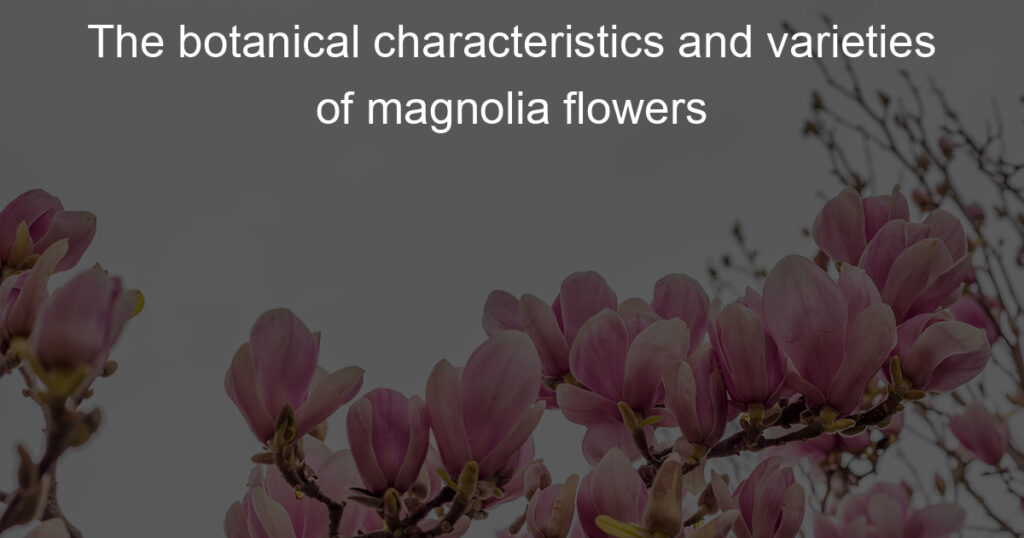Magnolia flowers are a sight to behold, with their large size and distinctive petals. There are many different species of magnolia, which vary in terms of color and appearance. In this blog post, we’ll take a look at the botanical characteristics of magnolias, as well as some of the most popular varieties. Whether you’re looking to add a touch of elegance to your garden or simply want to learn more about these beautiful flowers, read on!
What is the botanical name of the magnolia?
Magnolia is a genus of woody flowering plants native to the Eastern United States, Mexico, Central America, and Asia and known for their large and showy white or pink flowers.
The botanical name of the magnolia tree is Magnoliaceae, with Magnolioideae as the subfamily. This genus of flowering trees has over 200 different species in its family and can be either evergreen or deciduous depending on the species. Its flower petals range from two to nine in number and are often associated with purity due to its white color.
It is also regarded as being a timeless symbol of magnificence when small sprouts turn into larger flourishing trees. Throughout history, many cultures have come to recognize this tree’s beauty, leading to its presence in literature, paintings, and more commonly landscapes worldwide.
How do you identify a magnolia flower?
Identifying a magnolia flower is quite simple. Magnolias are known for their striking blooms, which come in a variety of colors and sizes that range from pale pink to bright white in some species.
Their flowers typically have up to nine large and thick petals with a cup-like shape. The undersides of magnolia flowers usually have red markings that can be used as identification markers. Additionally, their oval leaves are dark green with slightly fuzzy surfaces. Altogether, the beautiful combination makes it quite easy to recognize magnolia flowers.
What color are the flowers on a magnolia tree?
Magnolias are one of the most beloved trees due to their stunning beauty. The stunning flowers vary in shape and size and usually have a light pink hue and white inner cups. As they age, the petals grow darker and can eventually turn reddish-purple.
Magnolia blossoms appear from late winter through early summer, providing a great deal of beauty throughout any season. These graceful flowers also bring sweet aromas with them as well throughout the day, adding further delight to these wondrous trees.
What do magnolia flowers smell like?
Magnolia flowers are a pleasant surprise to the senses. Not only do these gorgeous blooms provide a stunning cascade of petals to behold, but they also offer an intoxicating scent that will linger in any home or backyard garden.
A whiff of magnolia is truly an aromatic experience—it’s delicate yet sharp with a hint of citrus and soft notes of honey that gives off an unmistakable aura of natural beauty.
Sniffing the blossom will transport you to another world entirely, making their delightful smell an essential part of the magnolia flower appreciation experience.
Are all types of magnolia flowers edible?
Magnolias are beautiful plants whose flowers can range in color from white to pink to purple and more. They are often used as decorative elements in gardens, yards, and bouquets, but they also have surprising uses other than just ornamentation.
While some types of magnolia flowers offer a tantalizing snack with their sweet nectar, not all of them are edible. Depending on the species, the plant’s blooms may contain compounds that could be harmful if ingested so it is important to ensure that you are familiar with what specific type of magnolia you have before introducing the petals into any food or beverage.
On the other hand, a variety of magnolia petals can make for interesting garnishes when fresh-picked and served as such. All considered these lovely blooms provide an aesthetic element to your landscape or plate no matter what form they take.
Final Impressions: The botanical characteristics and varieties of magnolia flowers
From the classic white blossoms of Saucer magnolias to the vibrantly colored blooms of star magnolias, these lovely flowers have been admired for centuries. They are also versatile and hardy, making them ideal choices for both gardeners and landscapers alike.
In addition, their ability to endure cold winters has made them popular in areas where frost and snow can be expected. Although magnolia trees may take some time to mature, there is no denying that they are worth the wait due to their fragrant beauty and strong symbolism of protection and perseverance.
Magnolias are not only a beautiful sight but also a reminder that despite any circumstance we encounter, we can stay resilient and appreciate the beauty around us.














